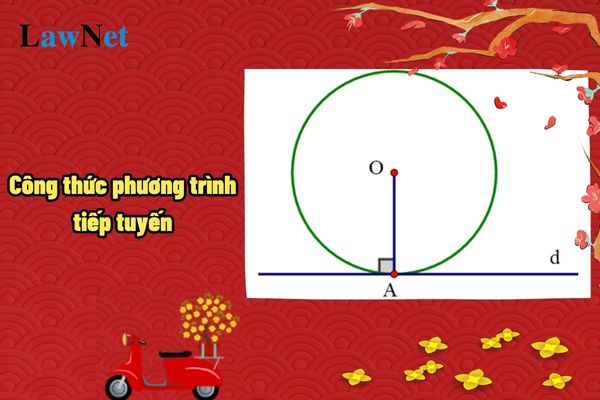What is the formula for the tangent line equation? What are the objectives regarding basic arithmetic and algebra skills of the 11th-grade Mathematics curriculum in Vietnam?
What is the formula for the tangent line equation?
11th-grade students can refer to the formula for the tangent line equation below:
|
What is the formula for the tangent line equation? The tangent line equation of the graph of a function at a given point is an important concept in mathematics, especially in Calculus. It represents the line that "touches" the graph of the function at exactly that point and has the same direction as the graph at the contact point. |
*Note: Information is for reference only./.

What is the formula for the tangent line equation? What are the objectives regarding basic arithmetic and algebra skills of the 11th-grade Mathematics curriculum in Vietnam? (Image from the Internet)
What are the objectives regarding basic arithmetic and algebra skills of the 11th-grade Mathematics curriculum in Vietnam?
According to the General education program for Mathematics at the lower secondary level issued together with Circular 32/2018/TT-BGDDT:
Mathematics at the lower secondary level aims to help students achieve the following main objectives:
+ Acquire basic mathematical knowledge and skills about:
++ Arithmetic and Algebra: Number systems (from natural numbers to real numbers); calculation and use of calculation tools; algebraic language and symbols; algebraic expression transformation, equations, systems of equations, inequations; using function language to describe (model) some processes and phenomena in practice.
++ Geometry and Measurement: The content of Geometry and Measurement at this level includes visual geometry and plane geometry. Visual geometry continues to provide language, symbols, and descriptions (at a visual level) of real-world objects (plane shapes, solids); creating some common geometric models; calculating some geometric elements; developing spatial imagination; and solving some simple practical problems associated with Geometry and Measurement. Plane geometry provides knowledge and skills (at a logical reasoning level) about geometric relationships and some common plane shapes (point, line, ray, segment, angle, two parallel lines, triangle, quadrilateral, circle).
++ Statistics and Probability: Collecting, classifying, representing, analyzing, and processing statistical data; analyzing statistical data through frequency, and relative frequency; recognizing some simple statistical laws in practice; using statistics to understand basic concepts of the experimental probability of an event and the probability of an event; recognizing the significance of probability in practice.
+ Contribute to helping students have initial understanding of careers related to mathematics; be aware of career orientation based on capabilities and interests, conditions, and circumstances of oneself; guide streamlining after lower secondary education (continue to study, vocational training, or join the workforce).
What are the characteristics of Mathematics at the lower secondary level in Vietnam?
According to the General education program for Mathematics at the lower secondary level issued together with Circular 32/2018/TT-BGDDT, the characteristics of 9th-grade Mathematics are as follows:
Mathematics increasingly has many applications in life, and basic mathematical knowledge and skills have helped humans solve practical life problems systematically and accurately, contributing to societal development.
Mathematics in secondary schools helps form and develop essential qualities, common competencies, and mathematical competencies for students; develop key knowledge and skills and create opportunities for students to experience and apply mathematics in practice; establish connections between mathematical ideas, between mathematics and practice, between mathematics and other subjects and educational activities, especially with Science, Natural Science, Physics, Chemistry, Biology, Technology, Informatics to implement STEM education.
The content of Mathematics often carries a logical, abstract, and general nature. Therefore, to understand and learn Mathematics, the Mathematics curriculum at secondary schools must ensure a balance between "learning" knowledge and "applying" knowledge to solve specific problems.
During the process of learning and applying mathematics, students always have opportunities to use modern technology and teaching equipment, especially electronic and handheld calculators, to support the process of representing, searching, and discovering knowledge, and solving mathematical problems.
In the general education program, Mathematics is a compulsory subject from grade 1 to grade 12. The educational content of mathematics is divided into two phases:
- Basic Education Phase: Mathematics helps students systematically understand the most essential mathematical concepts, principles, and rules necessary for everyone, laying the foundation for further education or everyday life use.
- Career-oriented Education Phase: Mathematics helps students have a relatively comprehensive view of mathematics, understand the role and applications of mathematics in practice, and careers related to mathematics to orient career paths and have the ability to independently explore mathematics-related issues throughout their lives.
In addition to the core educational content, each academic year, students (especially those oriented towards natural sciences and technology) choose to study some learning modules. These modules aim to enhance knowledge of mathematics, skills in applying math knowledge in practice, and meet the interests, needs, and career orientation of students.
The Mathematics program in both education phases follows a linear structure combined with a "concentric spiral" (concentric, expanding, and advancing) around and integrating three strands of knowledge: Numbers, Algebra, and Some elements of Calculus; Geometry and Measurement; Statistics and Probability.

